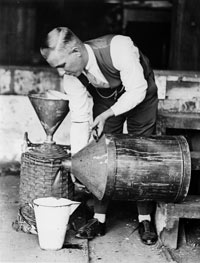 |
| ODN August 31, 1928 |
The reality, of course, is that - legal or not - people in Wisconsin had been brewing their own beer all along. In fact homebrewing’s greatest surge in popularity probably occurred during the dry years of Prohibition (1919-1933) when the surest way to secure your stock of beer was to make it yourself. Oshkosh, in particular, was a hot-bed of homebrewing during the 1920s and though the manufacture of any quantity of beer was strictly illegal the practice of homebrewing was so commonplace here that the act of making beer was taken for granted. Malt extract and hops were sold in most Oshkosh drug and grocery stores during Prohibition and the Oshkosh Daily Northwestern was dotted with advertisements for homebrew instructions and supplies. The paper even ran a number of features during this period that casually addressed the popularity of homebrewing and wasn’t above offering homebrew tips - “CHLORINATION OF WATER NOT GOOD FOR HOME BREW” warned a headline from the Oshkosh Daily Northwestern of March 19, 1932.
To get a sense of the agreeable approach that many in Oshkosh held towards the illegal practice of homebrewing, here’s an article that appeared in the Oshkosh Daily Northwestern almost 80 years ago, on November 25, 1930. The overall tone is somewhat sexist and short-sighted, but if you’ve ever brewed your own beer you’ll probably recognize a bit of yourself in the author’s words. The roots of homebrewing in Oshkosh run a lot deeper than 1978.
 Brewing A Home Art
Brewing A Home ArtPassing of the household arts is sometimes deplored. Pies, perhaps not of the kind that grandmother used to bake, come from the delicatessen shop around the corner. "Mother's bread" is the product of the bakery. Pickling and preserving has gone to concerns famous for 57 varieties, or numbers approaching that figure. But one of the ancient household arts is being revived. Fred Pabst, president of the Pabst corporation., which once played a part in the production of the beverage that made Milwaukee famous, estimates that the consumption of home brewed beer in the United States increased last year 18 percent. The estimate is based upon sales of malt syrups. More than that, home brewing continues to spread. The increase of 18 percent in a year compares with an increase of 34 percent in October, 1930, as compared with October, 1929. Here is a household art that tends to keep the men at home. The brewing of the family beer is a task that appeals to the man of the family. He is no longer a stranger to the kitchen, or the kitchenette, as the case may be. He may never have learned to cook steak or an omelet, but his technique in apportioning the syrup and the water approaches perfection, and he is versed in the temperatures to be maintained while the brew is "working." There are stern moralists who will deplore this spread of a household art. It may be made the subject of sermons on the tendencies of the times. There will be expressions of sorrow at the transformation of the land of the free into the land of freedom to brew. Others will see in this condition an argument for the legalizing of the sale of beer. If there is to be universal brewing why not let the brewery supplement the bakery? Then this latest of the household arts may again fall into a state of innocuous desuetude, save for the few. As there are housewives who bake bread in an era of bakeries, so there might be householders who brewed beer with breweries once more in operation. We might come to the time when the old-fashioned man would be described as one who brewed his own.






No comments:
Post a Comment